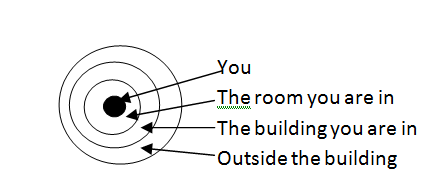Circle's of Concentration
The actor should not forget the audience, or try to believe it does not exist. That would be contradictory to the art of theatre. The audience is an important ‘co-creator’ of the performance.
Stanislavski realized early on:
"All of our acts, even the simplest, which are so familiar to us in everyday life, become strained when we appear behind the footlights before a public of a thousand people. This is why it is necessary to correct ourselves and learn again how to walk, move about, sit or lie down. It is essential to re-educate ourselves to look and see, on the stage, to listen and to hear." (An Actor Prepares pg77)
____________________________________________________
Concentration is the key
to ‘re-educating’ the actor
to ‘re-educating’ the actor
‘Circles of Concentration’(of attention).

Actors start in the smallest circle they can...
"Solitude in Public"
The actor, in the center of the small circle was secure within this circle, even before large audiences. This small circle could, then travel on stage with the actor, enveloping the actor ‘like a snail in its shell’ (An Actor Prepares pg 82).
As the circle grew larger, the actor learned to concentrate or focus on relatively larger areas of light, still excluding whatever was not in the circle.
EXERCISE
Must have a swim noodles for everyone in the class
ACTIVITY
Play music during the exercise.
Teacher prompts the next move.
Step 1
"Solitude in Public" - Students start by sitting inside a swim noodle that they have pulled into a ring. They stay there in meditation for 1 minute. They shouldn't close their eyes, but instead try to bring their focus into themselves within the larger space. Once they feel they are focused solely on their own physical being they move into a wider circle of attention.
Step 2
The actor should stand and keep the swim noodle as close to their body and their sphere of solitude as possible at first. Do not step out of the space being occupied.
Step 3
Then the actor expands their attention to the space that their noodle can take up around their own body. The attention should continue to be solely on their own space. The actors focus needs to remain entirely on their physical action. What every muscle is doing and how the breath feels. The extension of the noodle into the space around the actor's body.
*******************************************************************************
‘External’ and ‘Inner Attention’ (or concentration):
External Attention was directed to material or objects lying outside of the actor.
Inner Attention was based on imaginary life created by the actor that was consistent with
the given circumstances of the play. This inner attention incorporated all the five senses of the
actor. Since by nature life on stage depended on imaginary circumstances, ‘Inner Attention’
became extremely important to the actor.
'Intellectual Observation' and 'Emotionalizing':
After intellectually observing an object, the actor needed to create imaginary circumstances
around it. This would create a ‘story’ around it, thus emotionalizing the object, which would then set
in motion the actor’s creative apparatus to apply the proper action towards the objects on stage.
********************************************************************************
Stanislavski: Concentration of Attention
The fifth chapter of An Actor Prepares - "in order to get away from the auditorium you must be interested in something on the stage." This is usually a hard thing for actors to do; to separate themselves from the audience that is undoubtedly there.
They must occupy themselves by playing with props, textures, fabrics, and other things onstage in rehearsal to then use them believably in front of an audience.
In order to successfully do this, the actor must pay attention to their surroundings; both in the theatre and at home. They should become aware of the sights, smells, feelings, tastes, and sounds of things in their everyday lives.
*********************************************************************************
No comments:
Post a Comment